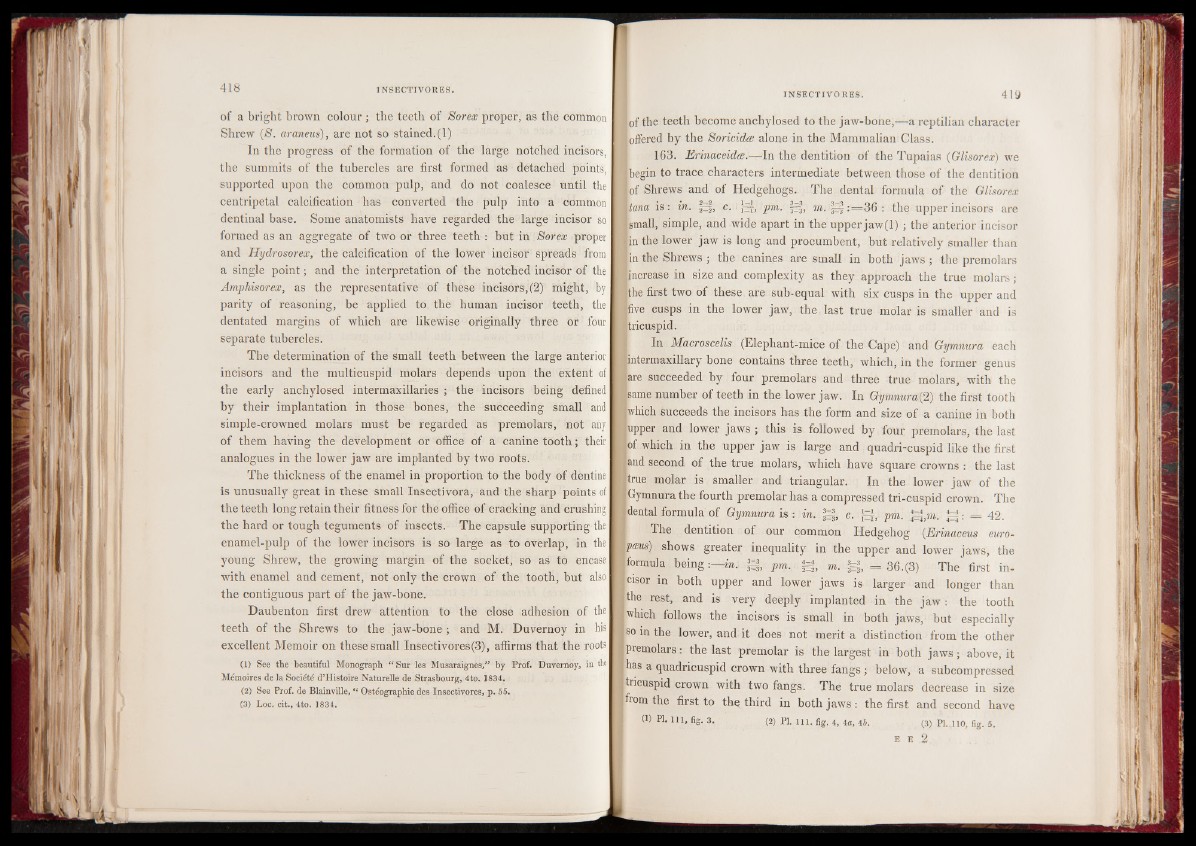
of a bright brown colour ; the teeth of Sorex proper, as the common
Shrew (S. araneus), are not so stained.(1) 1
In the progress of the formation of the large notched incisors,
the summits of the tubercles are first formed as detached points,
supported upon the common pulp, and do not coalesce until the
centripetal calcification has converted the pulp into a common
dentinal base. Some anatomists have regarded the large incisor so
formed as an aggregate of two or three teeth : but in Sorex .proper
and Hydrosorex, the calcification of the lower incisor spreads from
a single point ; and the interpretation of the notched incisor of the
Amphisorex, as the representative of these incisors, (2) might, by
parity of reasoning, be applied to the human incisor teeth, the
dentated margins of which are likewise originally three or four
separate tubercles.
The determination of the small teeth between the large anterior
incisors and the multicuspid molars depends upon the extent of
the early anchylosed intermaxillaries ; the incisors being defined
by their implantation in those hones, the succeeding small and
simple-crowned molars must he regarded as premolars, not any
of them having the development or office of a canine tooth ; their
analogues in the lower jaw are implanted by two roots.
The thickness of the enamel in proportion to the body of dentine
is unusually great in these small Insectivora, and the sharp points of
the teeth long retain their fitness for the office of cracking and crushing
the hard or tough teguments of insects. The capsule supporting the
enamel-pulp of the lower incisors is so large as to overlap, in the
young Shrew, the growing margin of the socket, so as to encase
with enamel and cement, not only the crown of the tooth, but also
the contiguous part of the jaw-bone.
Daubenton first drew attention to the close adhesion of the
teeth of the Shrews to the jaw-hone ; and M. Duvernoy in his
excellent Memoir on these small Insectivores(3), affirms that the roots
(1) See the beautiful Monograph “ Sur les Musaraignes,” by Prof. Duvernoy, in tin
Mémoires de la Société d’Histoire Naturelle de Strasbourg, 4to. 1834.
(2) See Prof, de Blainville, t: Ostéographie des Insectivores, p. 55.
(3) Loc. cit., 4to. 1834.
■ of the teeth become anchylosed to the jaw-bone,—a reptilian character
■ offered by the Soricidee alone in the Mammalian Class.
163. Erinaceidas.—In the dentition of the Tupaias (Glisorex) we
■ begin to trace characters intermediate between those of the dentition
■ of Shrews and of Hedgehogs. The dental formula of the Glisorex
mtana is: in. §E§, c. pm. fEf, m. |g§ :=36 : the upper incisors are
■ small, simple, and wide apart in the upper jaw(l) ; the anterior incisor
■ in the lower jaw is long and procumbent, but relatively smaller than
■ in the Shrews; the canines are small in both jaws; the premolars
■ increase in size and complexity as they approach the true molars;
■ the first two of these are sub-equal with six cusps in the upper and
■ five cusps in the lower jaw, the last true molar is smaller and is
■ tricuspid.
In Macroscelis (Elephant-mice of the Cape) and Gymnura each
■ ntermaxillary bone contains three teeth, which, in the former genus
■ are succeeded by four premolars and three true molars, with the
■ same number of teeth in the lower jaw. In Gymnura{2) the first tooth
■ which succeeds the incisors has the form and size of a canine in both
■ upper and lower jaws ; this is followed by four premolars, the last
■ of which in the upper jaw is large and quadri-cuspid like the first
■ and second of the true molars, which have square crowns : the last
■ true molar is smaller and triangular. In the lower jaw of the
■ Gymnura the fourth premolar has a compressed tri-cuspid crown. The
■ dental formula of Gymnura is : in. gj, c. jEy, pm. = 42.
The dentition of our common Hedgehog (Erinaceus euro-
mxEus) shows greater inequality in the upper and lower jaws, the
■ formula being: pm. n g , m. -g, = 36.(3) The first in-
■ cisor in both upper and lower jaws is larger and longer than
■ the rest, and is very deeply implanted in the jaw : the tooth
■ which follows the incisors is small in both jaws, but especially
jso in the lower, and it does not merit a distinction from the other
Ipremolars: the last premolar is the largest in both jaws; above, it
■ has a quadricuspid crown with three fangs ; below, a subcompressed
■ tricuspid crown with two fangs. The true molars decrease in size
from the first to the third in both jaws: the first and second have
(1) PI. Ill, fig. 3. (2) PI. 111. fig. 4, 4a, 4 b. (3) P l.jio , fig. 5.
E E 2